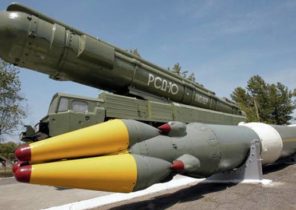1. Why the Victory Day — may 9?
The question of why the Victory Day is celebrated on the 9th of may, there is not one generation of students. And it’s not just that the West celebrates victory over Nazi Germany 8-th, and we are a day later — this is just all clear. The question arose for another reason: if Hitler committed suicide on 30 April, Berlin surrendered on may 2, why the war ended on may 9 in Prague and the surrender of Germany was signed still in Berlin?
If you try to find the original point in all this confusion, it is guilty in it will be Adolf Hitler. During his lifetime for the Germans, it was clear that while the führer is fighting, fighting in Germany, if the Fuhrer surrendered — the war is over. But Hitler died, leaving a will in which he appointed Reich President Karl Doenitz, Admiral, and Chancellor — Minister of propaganda Joseph Goebbels.
This division of power existed in Germany since 1934, when he died, President Paul von Hindenburg, and Hitler through a referendum has combined this post with his post of Chancellor. And it has created problems for understanding who is the power.
The basis of the Constitution of the Weimar Republic (the predecessor of the Third Reich in the years 1918-33), not formally abolished until 1945, the President of Germany had fewer rights than now in Ukraine. It was submitted to the Parliament the candidature of the Chancellor (but to appoint him he could only when the Reichstag was not of the majority coalition) and had the right of dissolution of Parliament. Everyone else was chaired by the Chancellor.
However, Doenitz who equipped an his residence in the North, in Schleswig-Holstein, issued a proclamation to the German people, which stated that the successor of the führer, he really is. As a result, many of you had a misunderstanding, where is the center of power in Berlin or in the residence Doenitz. Besides, there was another part, focused on Marshal Hermann Goering and Reichsfuhrer SS Heinrich Himmler, each of which conducted independent negotiations with Western countries and did not recognize any President, dönitz or Chancellor Goebbels. It was already not even dual power and polyarchy, not ukladyvaetsya in the minds of German.
So in terms of when the German army was shattered forces of the enemy into separate parts, each will have to decide who and when to give up. Do Berlin surrendered on may 2 — after 1 may, Goebbels committed suicide, but some of the armies on the Western front gave up another two or three days before. At the same time, part of the North of Germany, subject to Dönitz, surrendered only on may 5.
May 7 in the French Reims representatives Doenitz signed the act of surrender of Germany. Contrary to common belief that it was signed by the Western allies without the participation of the Soviet Union, the Soviet representative there was General Ivan Susloparov. However he had no authority to sign, and therefore made a note to Reims to act that subsequently need signing another full-fledged document of surrender. Which was signed on the evening of may 8 in the Berlin suburb of Karlhorst.
However, in both documents was the same time of surrender: 23:01 may 8, CET, or 1:01 may 9 in Moscow. It is the starting point for the celebration of Victory Day in any given day.
As for the end of the war in Prague, where the Germans really surrendered on 9 may, but is nothing more than a coincidence. Moreover, the war did not end: the surrender of German troops in Yugoslavia ended only on may 15, and in Austria — may 17.
2. Why the red flag over the Reichstag became a symbol of Victory?
Decisive in this matter was, in modern parlance, a PR component. The Reichstag — the German Parliament — the administration for Germany in 1945, no role playing. He’s not even going since 1942.
The real government was carried out from the Reich Chancellery building on Vossstrasse, however, by the time of the capture of Berlin a significant part of it was destroyed. Preserved, however, the bunker in the courtyard of the Reich Chancellery, where the Fuhrer spent his last days, however, this modest building was more like a warehouse and the photographs made no impression would be.
The Reichstag is in an open area and looks pompous, so for a symbolic installation of the Victory banner was selected instead. However, all this does not diminish the heroism of the red army elm, Yegorov and Kantaria, who hoisted the flag on the dome of the Reichstag, because the event really happened during the battle for the building on 30 April 1945, when Hitler committed suicide.
3. Hoped for Hitler, resisting until the last?
The main motivation for the German leader was that he could not and did not want to give up. Yes, and the world by Hitler no one to talk didn’t want. About the allies in 1943 agreed — no peace before the surrender. Moreover, after the surrender of Hitler’s fate was sealed — he would have been executed for war crimes. Therefore, no explanation to give up the Fuhrer was not. And although the summer of 1943 the outcome of the war was already clear, he found motivation for his army to avoid talking about surrender, and even about the world.
During the whole year such motivation was the promise of wonder weapons. But it was not about a nuclear bomb — although it was developed by German scientists, Hitler did not really believe in its effectiveness. “Wonder weapon” called the rockets “FAU”. In the summer of 1944, they were first used (first “V-1”, then a modified version of “V-2”) against the UK, and then it became clear that the “miracle weapon” does not determine the outcome of the war.
And in recent months, the Nazis fueled the hope that the Soviet Union and its Western allies will beat the pots and will take advantage of Germany, becoming, for example, an ally of Western countries against the Soviet Union. They proceeded from the fact that the US army and the UK many times inferior to the power of Soviet armies. So the only chance for the Western powers to stop the “rink of Stalin” — is to enter into an Alliance with Germany and its Wehrmacht.
Note that the logic in these arguments was. But only the Anglo-Saxons, of course, didn’t want anything to negotiate with Hitler. And “plan of Union with Germany” was implemented ten years later, when Germany was admitted to NATO and created half a million of the Bundeswehr on the basis of universal conscription. The emergence of the largest in Western Europe, the army has significantly corrected the imbalance in land forces between NATO and the USSR.
4. Whether Prague liberated “Vlasov” and not the Soviet army?
After the scandal with the monuments in the Czech Republic now often discussed the question of who actually liberated Prague in may 1945 — the Soviet army or the Nazi collaborators Russian Liberation Army (ROA) of General Andrei Vlasov. In fact, the version of the POA only to a small degree true. One of the divisions of “Vlasov”, indeed, participated in the battle of Prague against the Germans, but only until may 8. And a crucial role is not played. It all started with the fact that ROA, on the idea of the Vlasov voluntarily withdrew from the front and moved in the direction of Yugoslavia in connection with the local anti-Communist forces. The Germans gave it the command to return to the position, but the “Vlasov” is not obeyed them.
In the plans Vlasov did not appear help the anti-fascist uprising in Prague, but the plan came to one of his divisions, under the command of Sergei Bunyachenko, who thus wanted to earn the forgiveness of Americans (and many expect that they will go to Prague). This division, indeed, participated in the battles with the Germans in the Czechoslovak capital, but the rebels did not want to quarrel with the advancing red Army, after some time, refused an Alliance with the “Vlasov”.
And on the morning of 8 may, they left the city. Note that a major role in the liberation of Prague “Vlasov” could not play in because of its small size. One division of not been able to resist the hundreds of thousands of Germans, whose troops were deployed around the city. But Prague was liberated by the First Ukrainian front of Marshal Ivan Konev: at 4 am on 9 may, his troops entered the city, and at 16:00 which remained there the SS surrendered. So the demolition of the monument to Konev and the establishment of a monument to the “Vlasov” in Prague is not the restoration of historical justice, as just a political campaign to rewrite the past.
5. Is Stalin in 1945 dropped the “iron curtain”?
Today the dominant version of the beginning of the cold war is the one that in March, 1946, was announced by the former British Prime Minister Winston Churchill immediately after the war, Stalin from the Adriatic to the Baltic sea down the iron curtain, setting in countries of Eastern and Central Europe to the Soviet dictatorship. Interestingly, in the Soviet interpretation the starting point for the cold war was called the Churchill’s speech. In fact, however, neither the 1945 nor the 1946 years to consider the early years of the cold war impossible.
In 1945, of all the States of Eastern and Central Europe, the Communists became the ruling party only in three — Bulgaria, Yugoslavia and Albania, and in the latter two it happened without Soviet participation. Moreover, at the urging of Stalin in Bulgaria and Yugoslavia, the government included representatives of non-Communist parties. On the other hand, the Communists until 1947 was part of the governments of Italy and France. So, despite the friction between the former allies in the war, the first two years after the war the cold war can not be called.
The turning point was the proclamation in March 1947 the “Truman doctrine” in which the President of the United States announced a strategy of “containment of the Soviet Union around the world.” In this speech, Truman accused the Soviet Union in imposing totalitarian regimes on other countries, which at the time was not yet. In the same year a plan was announced the US financial assistance to the countries of Europe, which became known as the “Marshall plan”. Initially agreed with it not only Western countries but also, for example, Czechoslovakia with Poland, which proves a lack in 1947 “iron curtain”. Moreover, in the same 1947, the possibility of obtaining aid under the Marshall plan was considered in the USSR.
However, it soon became known that the financial assistance will be accompanied by political conditions by the same principle, which is now accompanied by conditions of IMF loans. By the way, the international monetary Fund was created in 1947 for control over execution of conditions of receiving financial aid. Because of political conditions from the Marshall plan, refused not only the future of the socialist country, but also Finland. And France and Italy, agreed on it, were forced to withdraw Communists from the government. And only in response to these actions by Stalin, indeed, began to drop an “iron curtain”, began the Sovietization of Eastern and Central Europe.
6. Why viatrovych war with Victory Day?
Statements about the fact that in 1944-1945, “one occupation was replaced by another” sound today in Ukraine — from the nationalist camp. Not accidentally, the Ukrainian nationalists are often found Nazi symbols: Ukrainian nationalism in the first years of the existence of the OUN (banned in Russia organization — approx. ed.) was an ally of fascism — first Italian, and since 1933, and German.
The descendants of the soldiers of the SS division “Galicia” really can’t count on 9 may Victory Day — because for them it is a day of defeat. That is why the leaders of the Ukrainian nationalist Volodymyr viatrovych is trying to erase this date from the calendar of state holidays. However, he understands that in a country where 80% of the population — the descendants of red Army soldiers, to make white black at one point impossible. Therefore, to shift uses the “European” version with a transfer date of 9 may 8, and replacing the celebration of the commemoration of the victims of war.
All these plans were officially published on the website of the Institute of national remembrance in the time of Viatrovych and not realized yet just because Poroshenko lost the presidential election. But the idea of moving the celebration on 8 may Ukrainians continue to impose, although, as already mentioned, it does not correspond to historical truth.
7. In may 1945 did the UPA (banned in Russia organization — approx. ed.)?
Despite its name, the Ukrainian insurgent army never conducted a classic fighting neither with German nor with the red Army — the forces were too unequal. Her element was the guerrilla war: the attack on the rear or the police stations/police Department with one goal — to get weapons. And the massacre of civilians — first over the poles and then on Ukrainians who supported the Soviet power.
And just in the spring of 1945, when Soviet troops finished off the Nazis, she launched a massive sabotage the war on the territory of Western regions of Ukraine, killing the officials, guest workers intellectuals and local residents, going on cooperation with “Tips”. There was also attacks on small detachments of Soviet troops. In relation to the German occupation authorities, the UPA this terror is not conducted. Her terror in 1943-1944 more about poles — civilians and the underground home Army.
By the way, the UPA intensified in the second half of 1944 due to the runaway soldiers of the SS division “Galicia” and due to the fact that the German administration, retreating, left the Ukrainian nationalists considerable stocks of weapons. Therefore, the peak activity of the UPA occurred in 1945.
That is, the Ukrainian insurgent army at the end of the war made in fact an ally of Nazi Germany. And its ideological leader Stepan Bandera by the time was released from the concentration camp and lived in the wild under the wing of the Nazis (and after 1945, the Americans).
8. How many Soviet citizens died in the great Patriotic war?
With this question, as on the date of the end of the war, there is confusion. The most famous figure of 20 million people, which was published in many movies, books and articles throughout the Brezhnev period. But the first figure was named under Joseph Stalin — 7 million people. It is believed that Stalin specifically understated the number of dead citizens, not to show the world that victory was achieved thanks to the huge number of victims.
But everything was different: published in the mid 1940s, the figure is actually the result of calculation of combat losses of the Soviet Union, that is, of counting the dead in the battles with Nazi Germany and died of wounds the soldiers of the red army. This figure even today, after all the refinements, is 6.8 million soldiers and officers. However, more often appears the figure of 8.7 million military personnel — but this is subject to the 1.9 million soldiers and officers who died in captivity.
As for the General losses of the USSR, under Stalin, they were not published for reasons of secrecy — because it was believed that the Americans will be able, based on these data, to adjust its estimate of the Soviet military-industrial potential. Therefore, the total number of dead Soviet citizens — 20 million was named in 1959 — is Nikita Khrushchev. But under Mikhail Gorbachev in the late 1980s, there was a third figure — 27 million (more specifically, 26.6 million).
As for the military losses of the USSR and its opponents, they are comparable: 8.7 million Soviet soldiers and 7.1 million Germans and their allies. It should be noted that in Soviet captivity died much less enemy soldiers and officers than in the German.
9. When the Soviet Union started to celebrate the Victory Day?
May 8, 1945, when Stalin already knew that the evening would be signed the capitulation, the Presidium of the Supreme Soviet of the USSR issued the decree on declaring may 9 the Day of Victory and a day. And so he remained for two years, 1946 and 1947. But on December 23, 1947, the same Bureau issued another decree according to which on may 9 was a work day. Why Stalin made such a decision, no one can say. The official explanation is, in the same decree: cancelling a non-business day may 9, he introduced a day off on 1 January, which was a working day.
And then the power to the output treated very sparingly: there was an official six-day working week for 8 hours, and the hours were only 7 days: in 1948 it’s a New year, a Day of remembrance of the victims of bloody Sunday (cancelled since 1951), may 1-2, 7-8 November and Constitution Day (5 December). Moreover (and remember that everyone who lived in USSR), if the holidays fell on a weekend, then no they are not compensated. In the same 1948 on the only day off — Sunday — we had 2 may, 7 November and 5 December, so that power lost only 4 days.
Of course, the time savings is the weak version. If Stalin really appreciated the Victory Day, it could be for the New year to donate to Bloody Sunday or on may 2.
Author of several sensational books about the Second world war Viktor Suvorov published a version according to which Stalin abolished the celebration of Victory Day because it is not believed that the war ended with the victory of the Soviet Union, saying that he did not conquer all of Europe, but because socialism was forced to coexist with capitalism was doomed to failure. Version is beautiful, but ridiculous. It turns out that in 1945, 1946 and 1947, Stalin believed that they had won, and then suddenly ceased to think so.
There is another version: in 1947, fell into disgrace, Marshal Georgy Zhukov, and the holiday was canceled, so as not to be reminded of his heroic deeds during the war. But it ignores one fact: in the years 1945-1947 the weekend was not only on 9 may and 3 September — the Day of Victory over Japan, which was also canceled. And to this victory, Zhukov had no relationship.
More likely the third version: in 1947, began the cold war with the West. And Stalin didn’t want to remind people about the days when the USSR and the USA were allies. Anyway, but on may 9 for 17 years, noted after the end of the day. Only in 1965, immediately after the removal of Nikita Khrushchev, the Victory Day declared a holiday.
To power in the USSR, it is generation headed by Leonid Brezhnev, who fought in WWII, and survived the revolution in childhood. Therefore, the Day of Victory gradually began to move in the list of holidays in the first place, pushing on 7 November.







